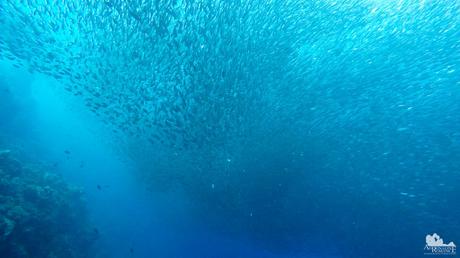
Aquariums, zoos, marine parks, and certain tourist attractions have allowed people to interact with rare wildlife. Amazing as these attractions are, we cannot deny the fact that these animals are housed and presented in a controlled, if not artificial, environment. Their behavior and habits are far from natural. That is why we favor adventuring in the wilderness. We just love the spontaneity, excitement, and magic of a wild encounter. And that is exactly what we got when we dived in Sardine Point in Panagsama, Moalboal in southern Cebu, Philippines.
Our experience dictates that early mornings are some of the best times to scuba dive. So at just around 6:45 AM, we geared up with our guide Jojo of South Cebu Adventures and headed towards the shore. Our plan was to dive 60 feet down a popular dive spot called Sardine Point—you’ll see why it is called so in a while.
The morning sun was bright and beautiful, and within a minute of swimming to deeper water, we descended into the deep blue.
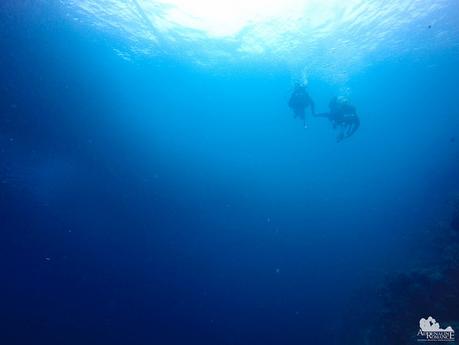
I was ready to go down a little deeper when Sweetie suddenly tugged my scuba tank, screaming in her regulator excitedly and pointing urgently towards open water. At first, I couldn’t make out what she’s pointing at, but as my vision adjusted to the blue hue, I could make out a dark, menacing shape less than 50 feet away.
It was the shadow of a huge whale shark! Unbelievable! Unfortunately, it was already swimming away when I saw it. But Sweetie had great luck; it was swimming right beside her when she saw it!
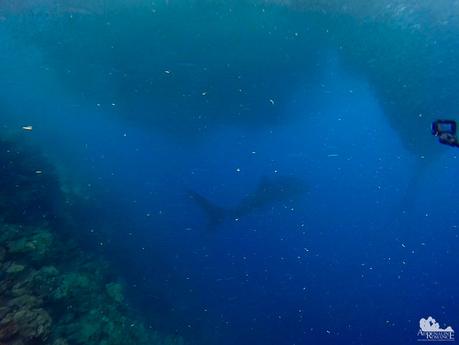
As the shadow disappeared (and after catching our breaths), we moved forward and started to explore the wall. The most spectacular natural attraction of this wall is the massive sardine run, which is how this dive site—Sardine Point—is named. Snorkelers, free divers, and scuba divers all over the world come here to see this wonderful spectacle. The sardine run is at its thickest in front of Cabana Beach Club Resort.
The sardine run is so profound that you can even see individual fish from an elevated position off the water such as on Cabana’s gazebo.
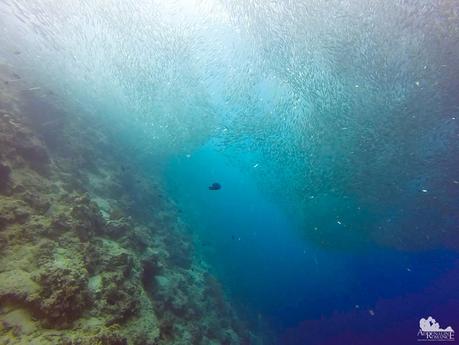
Millions of sardines school together near the water’s surface to escape from ferocious fish that prey on them from below. Schooling, synchronizing the way the swim, and darting out with lightning-fast speed also serve to confuse their predators.
But even with this highly effective defensive mechanism, many kinds of fish still manage to catch them. A few times during our dive, we could see a few large needlefish shooting like rockets from below, catching unlucky stragglers by surprise.

Because it was still early in the morning, there were no divers, snorkelers, and swimmers except Jojo, Sweetie, and me. Without any distraction or annoying bubbles, the cloud of sardines was extremely compact. In fact, like an underwater eclipse, it significantly blocked out sunlight that streamed into the water.
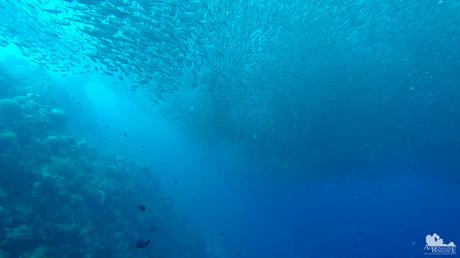
Enough of the sardines for a while. Let’s explore the coral-and-sponge encrusted wall. Due to the extensive marine life that inhabit the wall, Sardine Point is one of the most popular dive sites in Moalboal.
Sponges of all kinds like this stove-pipe sponge grow all over the reef. Sponges feed by filtering microscopic plankton from the water. They are very effective filter feeders.
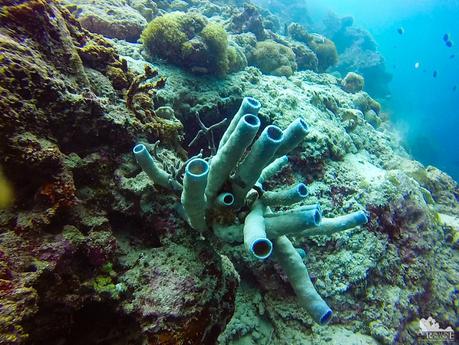
Many sponges, especially the large ones, have spacious cavities and chambers, which make them ideal homes and resting spots for all sorts of marine life. Here, a chelmonops butterflyfish swam to the safety of a 4-foot vase sponge as we approached to take a photograph of its home.
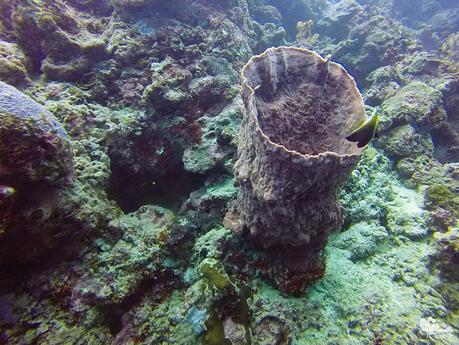
Farther ahead is a large barrel sponge that has a height of around 5 feet. But the word “large” is misleading because among mature barrel sponges, this one is actually just a little bit below average. We have encountered even larger barrel sponges during our dive in Anilao, Batangas. And several of our diver friends even encountered ones that are bigger than humans!
Unable to perform any sort of locomotion and without any significant organs, sponges are some of the most ancient and simplest multi-cellular animals on Earth.
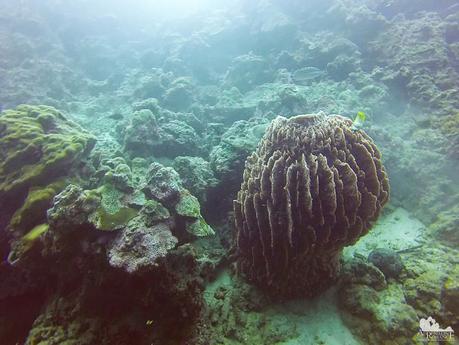
Along with sponges, corals are some of the simplest and most primitive yet fascinating and important reef builders. They provide homes and protective shelters for fish, shrimp, and mollusks. Here are some Nephtheidae, which we consider the flowers of the reef. Due to their sparkling beauty and pastel colors, they make popular salt water reef aquarium decorations.
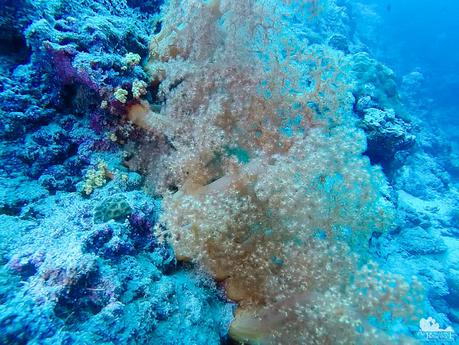
An expansive sea fan extends its reach so it could filter out plankton more effectively. The hazy, cottony white material that covers their darker exoskeleton are actually polyps, each with a number of tentacles that catch microscopic plankton.
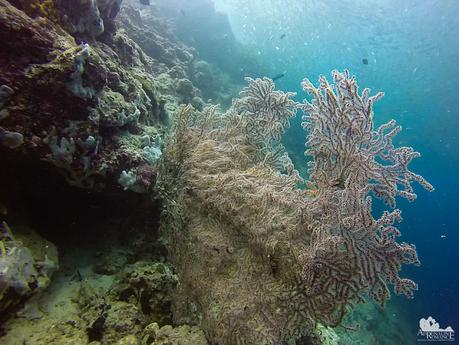
As we slowly cruised alongside Sardine Point’s wall, we found a number of interesting fish. A regal lionfish extended its pectoral and dorsal fins menacingly as we approached. Their sharp fin rays (those needle-like protrusions) contain venom, which they use to protect themselves. Lionfish are common in the tropics and are popular saltwater aquarium fish. But they have become serious parasites in temperate seas, their voracious appetites wiping out entire native fish populations.
Lionfish venom is rarely fatal, but it causes extreme pain. In some cases, the poison can cause breathing difficulties, dizziness, hearburn, and diarrhea. Fortunately, they are not aggressive towards divers.
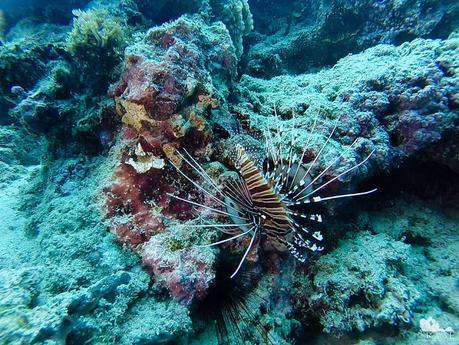
This is what you call hiding in plain sight! A slender pipefish rested on a brain coral after swimming against a gentle current. Check out the purple caudal fin at the rear, which acts like a paddle to propel the fish along.
The other fins of pipefish are usually absent or not properly developed. Thus, they are weak swimmers and need to constantly rest.
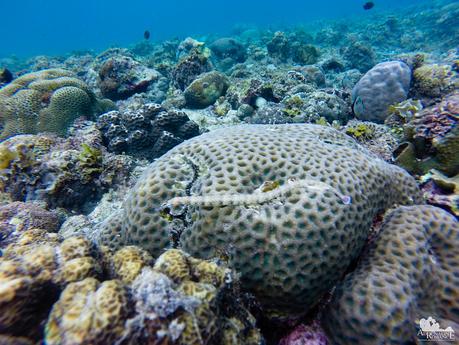
A small sharpnose puffer fish overtook us. Pufferfish can rapidly inflate themselves to twice or thrice their normal size to startle would-be predators. In addition, its puffed-up state makes it difficult for predators to swallow them. Finally, all species of pufferfish are highly poisonous. In fact, people have died eating improperly prepared pufferfish for dinner.
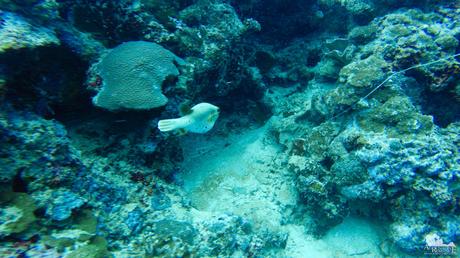
If not for Jojo’s sharp eyes, we would surely miss this black Ocellated frogfish, which looks like a shadow in the reef. Frogfish are masters of camouflage; they can change colors and textures to imitate the surrounding corals, sponges, and even rocks. Their near-perfect camouflage allows them to ambush prey who usually remain blissfully unaware.
Frogfish cannot swim like ordinary fish. Instead, they “walk” on the bottom, using their pectoral and pelvic fins to move around.
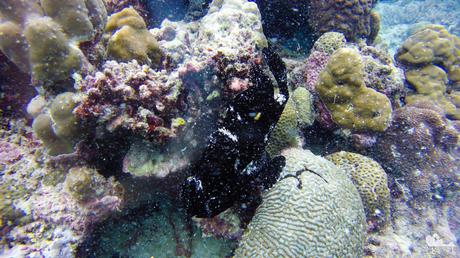
A little farther, we found a small yellow warty frogfish resting in a carpet of purple encrusting sponge. Its spinules—small dermal warts—were starting to take a purple coloration to match the color and texture of the sponge.
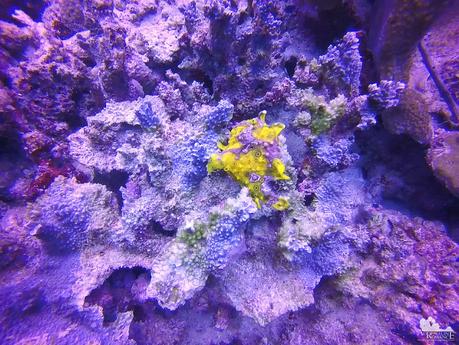
A shoal of juvenile stripped eel catfish hides underneath a small rocky overhang. I guess they got scared of my dive light. Although they are poisonous, they are not aggressive and would hide or run away when divers approach them. But for safety, I kept my distance. Just in case.
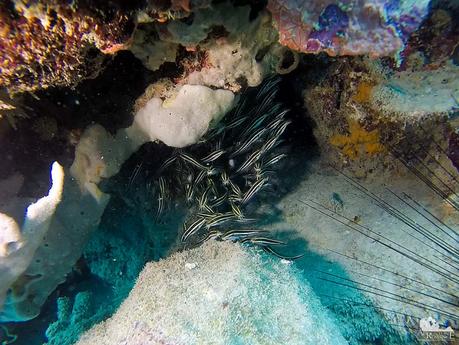
Some dives are uneventful. But this one had surprises all the way until we surfaced. One of these surprises was our first-ever glimpse of a juvenile Harlequin sweetlips. Because it is vulnerable to predation during the early stages of its life, the fish mimics the swimming movement and pattern of a poisonous flatworm. Fooled by the mimicry, predators would stay away from the Harlequin sweetlips, thinking it is deadly to eat.
Juvenile sweetlips move a lot, so it is quite difficult to take a good still shot of the fish. Thus, I made a video to show you how it swims. Really cool, isn’t it?
Then we came upon one of our favorite marine creatures, the graceful and gentle green sea turtle. This girl hasn’t yet shaken off that nice sleepy feeling—you know, you don’t want to get out of bed. Well, who can blame her? It was a lovely, relaxing, mellow Sunday morning. She napped on top of a rope sponge and didn’t really give a care when we approached close to her. Relaxing was more important for this lady.
All species of sea turtles are in the IUCN Redlist. That means, they are vulnerable, threatened, or critically endangered thanks to human greed, carelessness, and irresponsibility.

A long, large, yellow trumpetfish glided by the wall and started to check me out. Trumpetfish, along with the needlefish, are some of the most common hunters of sardines.
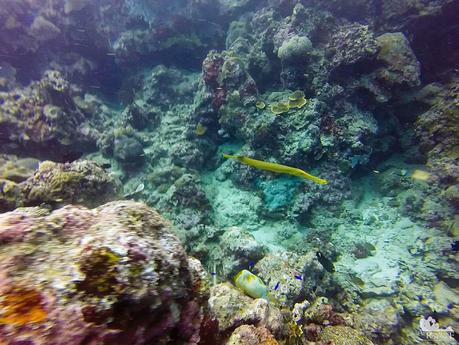
I was so engrossed trying to take good photos of the trumpetfish that I got completely startled when Jojo suddenly grabbed my scuba tank. Without any explanation or hand signal, he twisted me around into the blue.
And there it was—the giant whale shark we saw earlier, and it was just right below me! This is an incredibly rare whale shark sighting at the Sardine Point dive site in front of Cabana Beach Club Resort. It was probably curious of us as we are of it; that’s why it circled around for a closer inspection of three bubbling creatures. I was so happy that I squealed loudly in delight!
A few local kids who went for an early-morning swim saw it too. It became the morning’s sensation; and when we surfaced later, the locals were looking at us with approving, wide, and happy smiles.
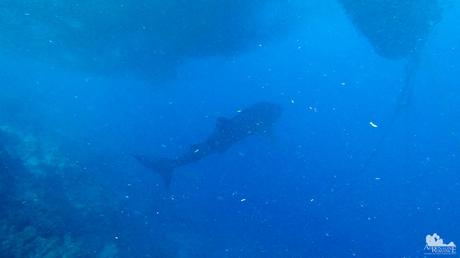
The best encounters are the wild ones! And this one was perfect; we saw this whale shark in its natural habitat. We did not encounter it in some poorly thought-out tourist attraction that actually harms their migration and feeding patterns.
The whale shark is the largest fish in the world, growing up to more than 40 feet in length. Although they are sharks, they are completely docile. They eat plankton, copepods, krill, and small fish.
The technical limitations of our GoPro Hero 3 Plus, the natural bluish hue of the sea, and the dark cloud of sardines above us makes the video below a little bit unclear. But to the naked eye, we saw the whale shark (as big as a minibus) very clearly—white spots, ridges, and all! What an exhilarating encounter!
On our way back, a few other divers began their morning dives. The bubbles from their regulators started to break away the thick cloud of sardines. It’s really fun to see how the sardines swim quickly in a coordinated pattern. It was virtually impossible to truly scatter them; in a few seconds, they rejoin the main school.
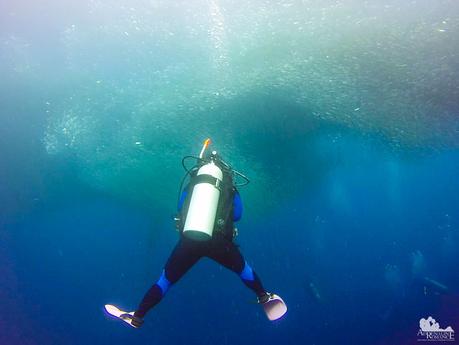
We skirted the edge of a tornado of sardines. Now, you might wonder why some of the fish have more a silvery sheen than others. Well, it seems that the more silvery fish act as guides for the rest of the school. Most probably, the rest of the school uses the silvery fish as visual cues.
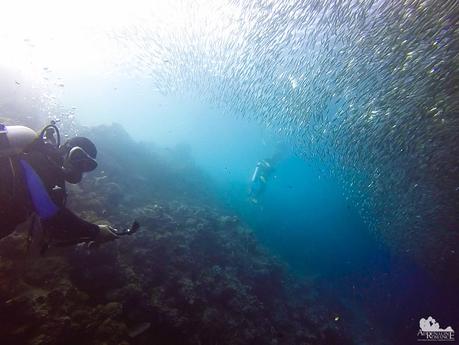
This fuzzy coral looks cute and innocent, but it’s particularly deadly—if you are a microscopic plankton. Hehehe! Check out the yellow-green polyps.

Although we saw this on many underwater photographs we found in the web, this was the first time we saw an actual red Dendronephthya, a type of soft coral. Pretty, isn’t it?
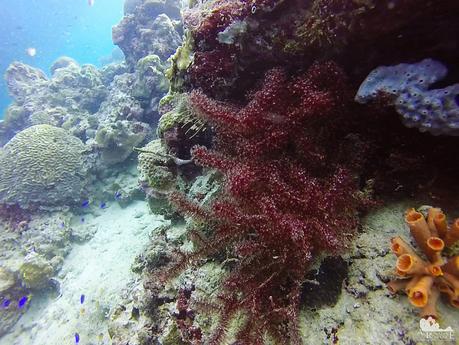
Is that a monstrous alien? Thankfully, no, but it could very well be. We wouldn’t be surprised if in the darkest recesses of the ocean, a tentacled monster that can wreck entire ships will suddenly emerge from the depths. After all, a vast majority of the beautiful and mysterious blue world hasn’t been studied, explored, or discovered yet.

We witnessed another natural spectacle although it was a whole lot lesser in scale than our whale shark sighting. On our way back, we saw a pair of damselfish attacking and feeding on three comb jellies who were desperately trying to escape the jaws of the fish. Apparently, as you can see in the video below, the jellies don’t stand a chance. They were being ripped apart.
It seemed that we were not the only couple swimming in Sardine Point. Two pretty butterflyfish swam in front of us. Judging at the way they were following each other and mimicking every move, they must be sweethearts like us.
Butterflyfish—along with damselfish, wrasses, and angelfish—are some of the most common fish found in tropical reefs.
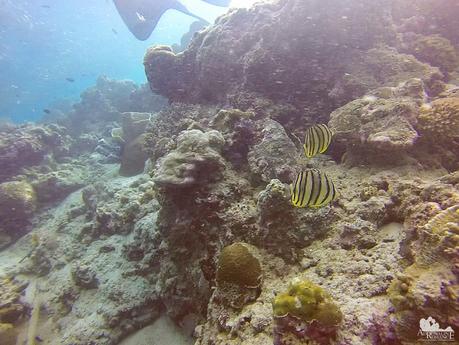
We had a 5-minute safety stop to decompress, allowing the nitrogen in our bodies to gradually dissipate in the lower ambient pressure of shallow water. While doing so, we glanced back into the blue, hoping that the whale shark will swim back. Unfortunately, it never showed itself again. Locals said we were extremely lucky; sightings of whale shark in Panagsama beach average around one every couple of years!

Indeed, the coast along Panagsama, Moalboal is one of the most popular dive sites in the Philippines. The thick sardine run, beautiful gardens of healthy corals, lively and colorful fish, graceful sea turtles, and rare sightings of giant whale sharks all make Panagsama a must-go place for everyone who loves the sea.
Along with witnessing the fascinating denizens of the reef, we could not believe we just saw a majestic whale shark in the wild on this dive. Totally unplanned. Totally natural. Totally raw. That’s how wildlife encounters are supposed to happen. As humans, we are simply visitors in this realm. We need to respect and adjust to their environment and not the other way around.
Who knows what would be our next sighting! Perhaps a thresher shark? A manta ray? A humpback whale? Playful bottlenose dolphins? We will never know. In the strange blue world, anything can happen. And we know that it is going to be utterly magical!
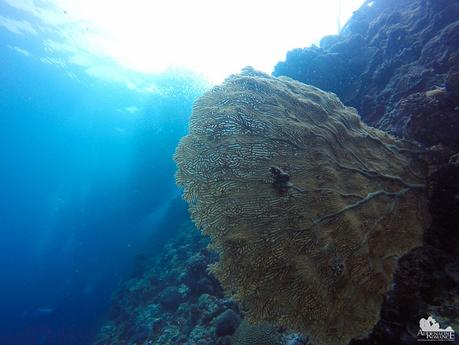
Getting to Panagsama Beach
At the Cebu South Bus Terminal, ride a bus that goes to Moalboal. Alight at the Moalboal town proper and take a tricycle to Panagsama Beach
- P 110 per person – one way, non-aircon bus from CSBT to Moalboal (P130 for aircon bus). The same rate applies for the return trip.
- P 25 per person – one way, tricycle fare from Moalboal to Panagsama Beach. The same rate applies for the return trip.
Contact Details
For your scuba diving adventures, get in touch with Jojo of South Cebu Adventures using the following contact details
- Contact Person: Cesario “Jojo” Indino, Jr.
- Position: Owner/Divemaster
- Mailing Address: South Cebu Adventures, Panagsama Beach, Moalboal, Cebu Philippines 6032
- Email: [email protected]
- Telephone: (032) 474-3283
- Cellphone: 0915-856-1375 / 0949-706-5568
- Facebook: South Cebu Adventures
South Cebu Adventures also offers other adventures such as:
- island hopping
- waterfalls hopping
- canyoning
- trekking
- and more!
Tips
1. There are more than two dozen dive sites around Panagsama and Pescador Island. You can’t finish them all in one day! But don’t worry because Moalboal has a lot of hotels, resorts, and other types of accommodation where you can stay. We recommend you stay in Cabana Beach Club Resort, which is right across South Cebu Adventures.
2. For optimum visibility, it is best to dive in the morning when the sun is shining and at the right angle. In addition, there are usually fewer divers in the morning, so heavy siltation is not likely to obscure visibility.
3. Several dive sites in Panagsama and Pescador have different conditions and characters. That means, some dive sites require a higher level of scuba diving experience and skill. Be sure to tell your Divemaster your skill level.
4. Establish neutral buoyancy as soon as you can to avoid touching the corals and seabed.
5. The dive shop will take care of your scuba equipment, so you don’t have to worry if you are not bringing your own set. Pack light but do bring the following:
- extra water ( at least 2 liters per person)
- swimwear such as rash guard and swimming shorts
- aqua shoes or slippers
- snacks or packed meals
- personal medication and toiletries
- waterproof camera
- mask and snorkel (for snorkelers)
6. Be a safe and responsible diver. Always observe the Leave No Trace principle. Never touch, disturb, tease, or collect marine wildlife. Remember we are in a protected area and an alien world that demands respect.
Save
Save
Save
Save
Save
Save

